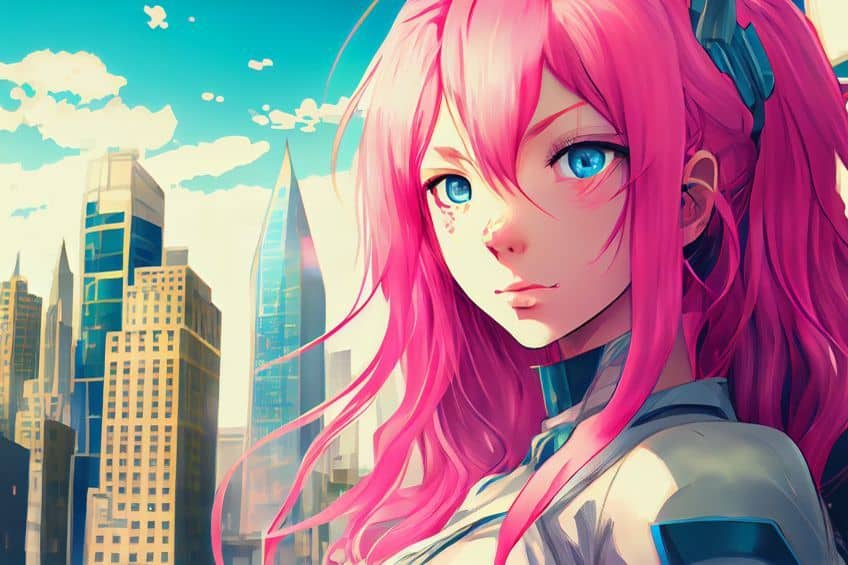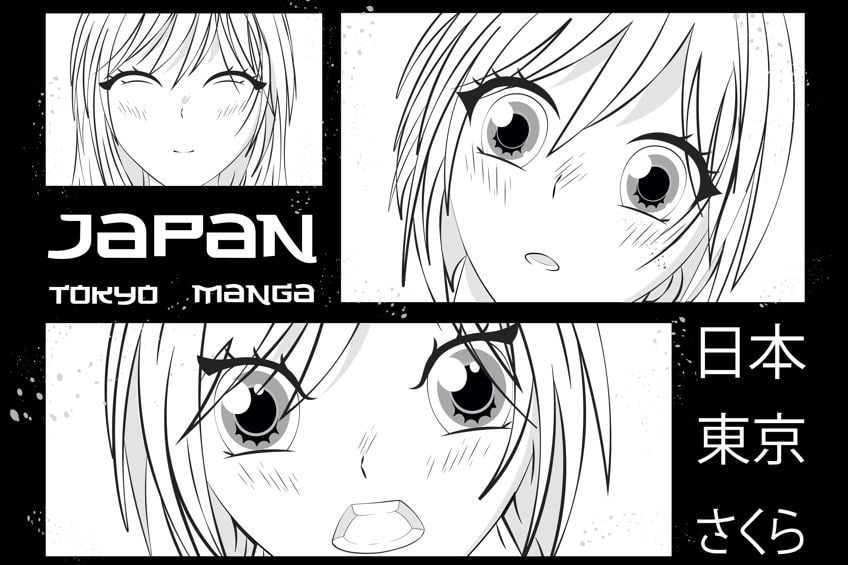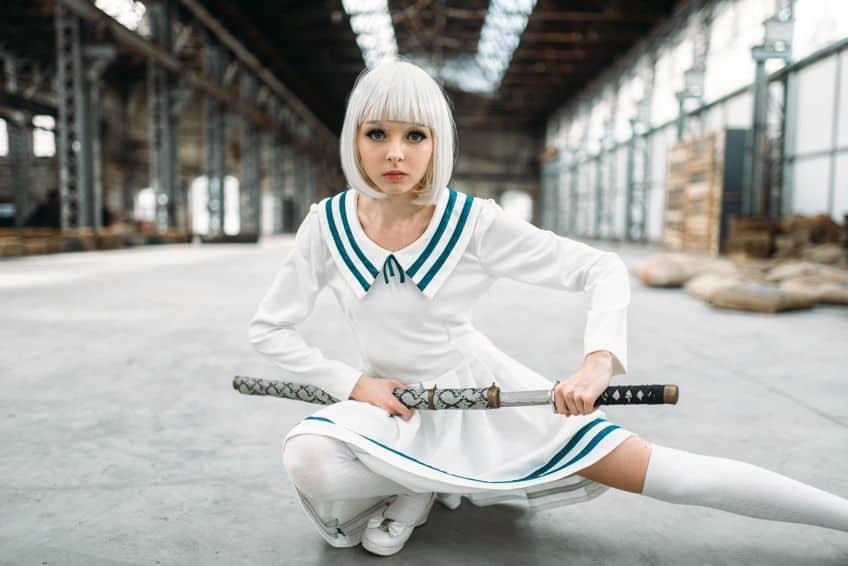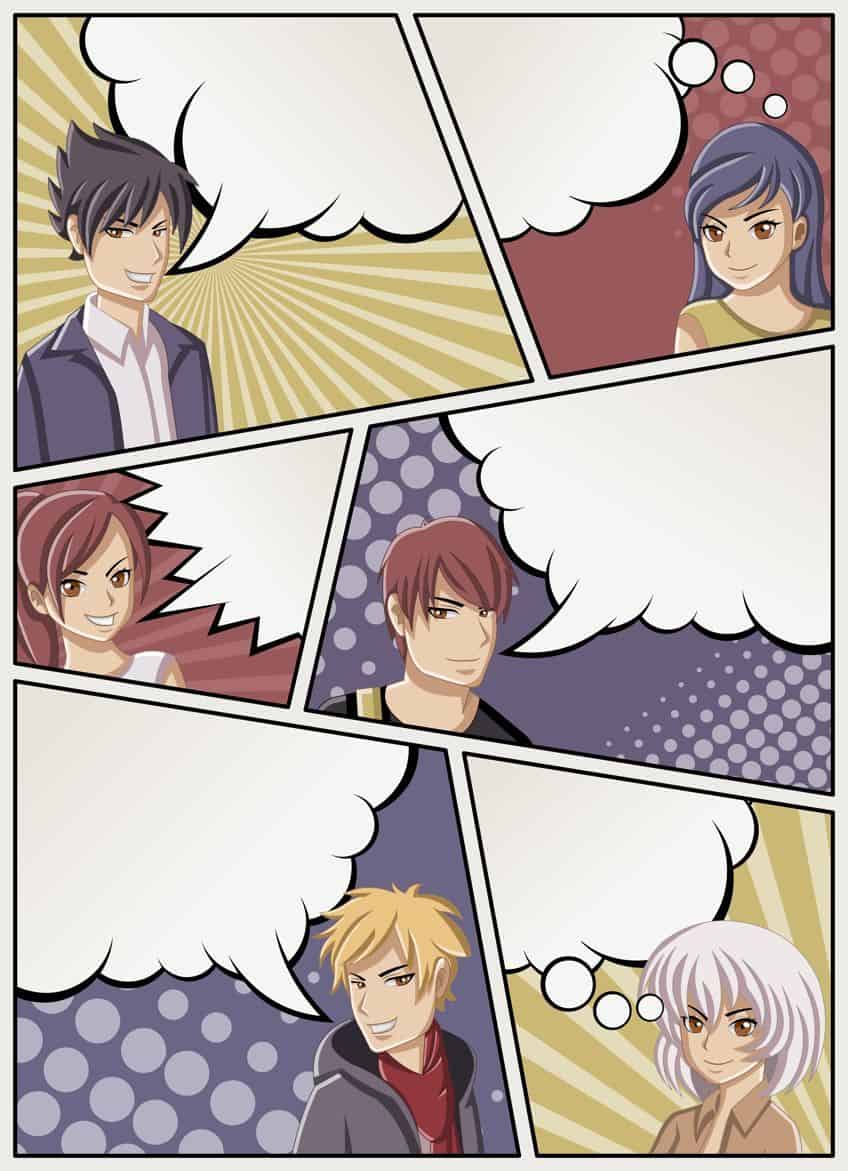What Is Manga? – The Famous Japanese Drawing Style
Manga has become a world-renowned form of Japanese art. Though it may be highly recognizable, you may be wondering what it is exactly. Is manga a genre or a type of comic book? Below, we aim to explore the deep history of Japanese comics and graphic novels, and try to answer the question of “what is manga”.
What Is Manga?
Manga is a broad Japanese term that is used when referring to comics and cartooning. The word has a narrower meaning among English speakers, however, and refers specifically to comic books and graphic novels that are published or produced in Japan. Manga is not just one genre; rather, like with graphic novels from other parts of the globe, manga includes works from a large variety of genres including romance, action, comedy, adventure, fantasy, science fiction, and much more.
Manga are usually released chapter-by-chapter on a weekly or monthly basis in Japan, and many are available in other languages. Popular series are sometimes published as volumes containing multiple chapters, which are known as tankōbon volumes. These volumes come in both hard- and softcover varieties and are often made with higher-quality paper, or even printed in full color.
The majority of manga series span multiple volumes, which should be read in the order they are released. This is important to keep in mind when you are considering starting a new series. Smaller series with only 10 volumes are easier to catch up with compared to larger series, which can have over 40 volumes.
Most of the manga today follows the style that was developed in late 19th century Japan, giving it its distinct style.
A Brief History of Manga
Japan’s history is closely tied to the history of manga. Many writers have recognized two main forces that shaped the development of manga into what it is today. During the Meiji Restoration and rise of Japanese Imperialism, manga was an avenue of spreading pro-imperialist propaganda and promoting Japanese leadership prior to World War II’s end.
The Allies occupation around the same time was the other influencing factor on the development of manga. With the Allies’ occupation of Japan and its constraints on propaganda and militarism, Japanese artists could turn to delving into and further developing their artistic styles and techniques. The Allies brought over their own art styles and themes seen in United States television, film, and cartoons, and comics at the time. This led to Japanese artists incorporating an infusion of Western media and its own themes and later became the Japanese comic we know today. In 1874, the first manga magazine called Eshinbun Nipponchi was created by Kawanabe Kyōsai and Kanagaki Robun.
The magazines continued to gain popularity, especially during 1905 with the Russo-Japanese War.
What Was the First Form of Manga in Japan?
The first known instance of a manga-like media dates back to the 12th century and are a set of four emakimono picture-scrolls called Chōjū-jinbutsu-giga. Later during the Edo period, the Toba Ehon was created, which was a book of drawings that formed the basis of what we call manga today.
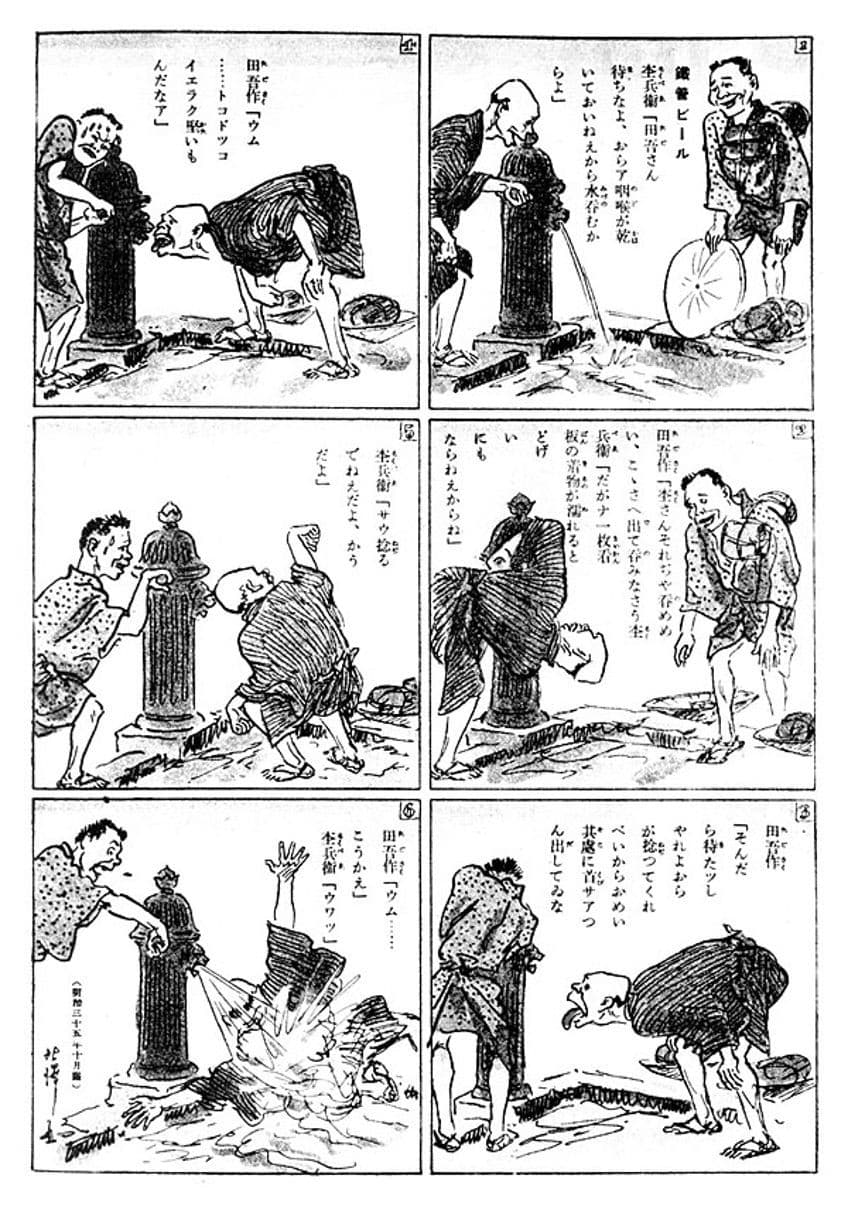
The term “manga” itself was first used in its modern form in the late 1700s to refer to picture books, such as Shiji no yukikai (1798) by Santō Kyōden. By the 19th century, the term was commonly used throughout the region and was included in the title of many sketchbooks, comics, and picture books. Some of the earliest examples of this are Katsushika Hokusai’s Hokusai Manga books (1814-1834). These works became the first form of manga
Popularity of Manga Worldwide
Although manga has existed in some form since the 18th century, it was not until the 1950s that it became a major player in the Japanese publishing market. Today the manga market in Japan is worth over ¥675.9 billion and continues to grow. Manga has not just reached popularity in Japan but has a worldwide following.
During the 1990s and early 2000s, manga gained a significant readership in the West.
This was partly due to the popularity of Japanese anime series such as Dragon Ball Z that aired at the time. These television series were adaptations of well-liked manga series and drove the exponential climb in readership in the U.S. By the 2010s, manga started to outsell American comics and served as a gateway for many into Japanese culture. Manga has served as a way to fuel interest in the culture as well as a large part of the tourism industry of Japan. This has been especially beneficial for lesser-known landmarks and regions.
Web Manga
Aside from traditional hardcopy releases, manga is also released digitally online as web manga. The increase in image hosting sites has led to a rise in web manga as it allows users to upload their works for free. One of the most popular web manga sites is Pixiv, which contains series from both professional and amateur artists. Like physical manga works, many web manga release chapters weekly and are usually in black-and-white.
Many popular manga series also have digital releases alongside the hardcopy.
This allows them to reach a broader audience without much extra costs. The sales of physical manga have seen a decrease over the last decade, however, digital manga sales have seen exponential growth. The rising popularity of web manga since the 2010s is also largely due to the widespread use of smartphones and computers, as it makes it more convenient for readers to view manga digitally than having to purchase a physical copy.
The Characteristics of Manga
Manga has many characteristics that make it unique to other forms of graphic storytelling. Its art style and storytelling techniques differentiate it from graphic works from other regions and provide a unique reading experience.
The Unique Art Style of Manga
Manga has a unique visual style compared to English-language publications. The art style of manga consists of simplistic but iconic character designs that are contrasted against very detailed and realistic backgrounds. Manga is traditionally read from right to left, unlike English publications that are read from left-to-right, and makes use of panels for storytelling. Some translated publications stick to this format while others mirror the panels to make the reading directed similar to English works. This is known as flipping and makes manga easier for foreign consumers to read, however, it does have some disadvantages.
Flipping contradicts what the creator originally intended and disrupts the flow of reading from panel to panel.
If care is not taken when flipping a series, the translated text could work against the flow of the panels. When this occurs, the text could state that the character is referring to something to their left while the graphic shows them pointing to the right. Flipping can also cause more minor issues such as showing characters who are typically left-handed write with their right hand or show the brake pedal on the right instead of the left. While these issues can be distracting, they are not as intrusive as disrupted reading flow and can usually be avoided with more active translation adaptation versus simply flipping the work.
Manga is also typically published in black-and-white unlike American publications, which are typically released in full color. Printing in black-and-white also helps to keep down costs and counteracts time constraints between manga issues, particularly ones with weekly releases. Many artists also prefer to print in black and white as they feel that color is distracting or lessens the impact of the artwork. Even web manga series are released in black-and-white despite many not receiving any physical productions. Full-color manga prints are usually reserved for special releases or volumes.
Storytelling Techniques in Manga
Manga uses a collection of storytelling techniques to give the reader a strong sense of participation within the story. Rather than observing from the outside, readers feel immersed in the story as though they are a part of it. There are eight main storytelling techniques that manga uses to achieve this feeling.
These include iconic characters, character design variety, wordless panels, realistic backgrounds, a strong sense of place, genre maturity, emotionally expressive effect, and subjective motion.
Expressions and Subjective Motion
Both the emotionally expressive effect (EEE) and subjective motion within manga makes the reader feel like they are a part of the story. EEE places readers within the same frame of mind and emotion as the characters in the story while subjective motion makes readers feel as though they are part of the action.
Iconic Characters and Strong Sense of Place
As mentioned above, iconic characters and detailed backgrounds form an integral part of the unique manga art style, however, these characteristics also play a part in the storytelling techniques of manga. Simple character designs that are iconic and varied makes it easier for the reader to identify and differentiate between characters.
The realistic and detailed background of the panels produces a strong sense of place.
When combined with wordless panels these background scenes give the reader the sense of being inside the universe of the story and allows them to connect their own experiences to the story, creating a stronger attachment to the universe and its characters. Genre maturity also provides manga with the ability to satisfy a wide range of readers’ interest.
Themes and Genres of Manga
Manga comes in a large variety of genres from whimsical fantasies to serious dramas and even sub-genres such as “magical girl”. A key component of manga is the over-exaggerated situations and settings that many characters find themselves in irrespective of the genre.

Different Types of Manga
Unlike Western novels, manga is primarily categorized by its target audience and then its genre. For example, Kazuki Takahashi’s Yu-Gi-Oh! is categorized as a shonen (for young boys) adventure fiction. There are six broad demographics that manga are classified into. These are divided by age and gender, with each category focusing on certain genres and themes. These classifications do not mean that you cannot enjoy series from different categories, it is merely how these manga are marketed.
Age or gender divides ultimately mean little, people can enjoy various types of manga according to their own tastes regardless of classification, and many manga actively subvert genre traditions and expectations.
Kodomomuke Manga
Kodomomuke manga is targeted at young children, usually younger than 10 years old. These manga series will often be fun and cutesy. They also usually have a strong moralistic focus and include life lessons or teaching children about staying on the right path. The stories themselves are simplistic and often concentrate on genres such as adventure. Although these series might have overarching stories, each chapter is typically self-containing. Kodomomuke manga can comprise of original stories or even adaptations of classical Western literature and children’s fairy tales. The Pokémon series written by Hidenori Kusaka is one of the most popular Kodomomuke series and is known worldwide.
Shonen Manga
Shonen manga is aimed at younger male audiences such as teen and tween boys. These manga series will often be action-packed and filled with comedy, adventure, and fighting, although there is usually not much gore. They almost always contain coming-of-age stories with a focus on the camaraderie and friendships between characters.
A lot of these manga series focus on a young male protagonist, although shonen series that follow with female protagonists are becoming more common in recent years.
These manga mainly concentrate on genres such as action, science fiction, adventure, and fantasy. Shonen Jump is the American counterpart to Weekly Shōnen Jump manga magazine, which has published some of the most popular shonen series over the last three decades. These include well-known shonen series such as Masashi Kishimoto’s Naruto and Kohei Horikoshi’s My Hero Academia.
Shojo Manga
Shonen manga is aimed at younger female audiences such as teen and tween girls. These series have less action than shonen manga, and instead focus more on drama and idealistic romance. As with shonen series, shojo manga also contain coming-of-age elements as well as a focus on the camaraderie and friendships between the characters. These manga tend to follow a young female protagonist and make use of cute and delicate imagery. These manga usually include genres such as drama, fantasy, and romance, as well as some action and adventure. Arguably the most famous icon of shojo series is Naoko Takeuchi’s Pretty Guardian Sailor Moon, which is more commonly known as Sailor Moon.
Seinen Manga
Seinen manga is targeted at men over 18 years of age. Like shonen, these manga series are action-packed, however, they contain much more gore, violence, and other adult themes. Sexual themes and nudity are also very common in these series, and it has an overall darker and more serious tone than those aimed at younger audiences. This is not to say that these series do not contain comedy and lighthearted adventure. Seinen manga are more realistic in contrast to the idealistic worlds of shonen manga. Protagonists aren’t guaranteed victory or happiness, and the characters and their motivations are often more complex rather than simply good versus evil.
Seinen is also often used as a catch-all category for when a series does not fit others like Shonen or Shojo.
Seinen series tend to follow a male protagonist, however, female protagonists are becoming more common like with shonen series. Akira, a creation of Katsuhiro Otomo, is maybe the most familiar seinen series around, largely due to an impressive adaptation into anime that was the forerunner of the Japanese style of animation and responsible for its prevalence in the Western markets. Other examples of the seinen genre can be found in the popular series Monster with Naoki Urasawa as its writer and illustrator.
Josei Manga
Josei manga serves as the counterpart to seinen manga. These manga are targeted towards women over 18 years of age. Unlike the idealistic relationships seen in shojo manga, Josei manga has more realistic and complicated romances and friendships, and often deals with darker and more mature subjects such as infidelity. Like seinen series, sexual themes, and nudity are also common in these manga.
Josei manga typically includes genres such as romance, slice-of-life, and drama, however, action and adventure genres have become more popular in recent years as well. These series also feature both female and male protagonists, although female protagonists are more common. Homosexual relationships are also more common in josei manga.
Ta’amo’s House of the Sun is a well-known josei series that deals with themes of remorse, abandonment, and persevering hope, and went on to win the 38th Kodansha Manga Award in 2014.
Manga vs. Anime
You may have heard the term anime and manga used together; however, they are two very distinct forms of media. Both anime and manga are terms for media produced in Japan and share a similar art style, so it can be easy to confuse the two.
Differences Between Anime and Manga
The key distinction between the manga art form and anime is that manga is printed works while anime is animated works. Like with manga, anime is the term used for all animated works in Japan, however, only refers to animation produced and created in Japan in the rest of the world. Some also see anime as an animation art style that refers to any work made with this distinct style as anime, irrespective of its origin.
As with manga, anime has something for all ages and covers many types of stories and genres.
Adaptation of Manga into Anime
Many popular manga have anime adaptations, which allows their fans to experience their favorite characters in a fresh way and attract new readers to their manga. Examples of popular manga that were adapted to anime include Demon Slayer: Kimetsu no Yaiba and JoJo’s Bizarre Adventure. Although they are less common, there have also been some cases of popular anime series being adapted into manga such as Code Geass and Angel Beats!
A Note on Fan Service
Many manga series, especially those targeted at male audiences such as the Seinen series, contain fan service. Fan service is the oversexualization of characters, which is done to please readers. These include putting fan-favorite characters in situations that are pseudo-sexual or end up with them dressed in revealing clothing. These acts never serve to further plot or result in character development, but rather exist purely for the pleasure of the reader.
In male targeted manga especially, female characters are disproportionately put in compromising situations and forms of sexual assault played off for a laugh. Because of this
Fan service is different to explicit sexual content found in hentai or erotic manga. It is also different to ecchi, which is works that contain large amounts of sexual humor or playful sexual actions that are not explicitly pornographic. Fan service appears in almost all varieties of manga but range in frequency and explicitness, making certain manga inappropriate for young children.
It is important to research or read through manga before giving children access to ensure that they do not contain any inappropriate materials. There are countless rich and well-developed manga for your kids to read that do not contain this gratuitous content or incorporate it infrequently and in a harmless fashion.
Manga is a rich and vibrant art form that has a long history in Japan. It has grown to have a popular following worldwide, often outperforming local productions. While this article serves as a general introduction to manga, there are many other aspects to explore such as interesting genres, tropes, and unique stories.
Frequently Asked Questions
What Is Manga?
In Japan, manga is a term that primarily refers to graphic novels, but can also include cartooning and comics. In the West, the term manga is used almost exclusively to describe graphic novels, cartooning, and comics that are created and produced in Japan. Manga also has a very distinct art style and is often produced in black and white, unlike Western graphic novels.
Is Manga a Genre?
No, manga is not a genre but rather a form of graphic novel. As with western novels and comic books, manga is produced in many different genres including drama, comedy, action, romance, fantasy, and adventure, to name a few.
What Was the First Form of Manga in Japan?
The Chōjū-jinbutsu-giga is a collection of four emakimono picture-scrolls depicting a series of frolicking animals and is largely regarded as the first form of manga-like media. These scrolls date back to the 12th century and are regarded as a national treasure in Japan.
Liam Davis is an experienced art historian with demonstrated experience in the industry. After graduating from the Academy of Art History with a bachelor’s degree, Liam worked for many years as a copywriter for various art magazines and online art galleries. He also worked as an art curator for an art gallery in Illinois before working now as editor-in-chief for artfilemagazine.com. Liam’s passion is, aside from sculptures from the Roman and Greek periods, cave paintings, and neolithic art.
Learn more about Liam Davis and about us.
Cite this Article
Liam, Davis, “What Is Manga? – The Famous Japanese Drawing Style.” artfilemagazine – Your Online Art Source. August 31, 2023. URL: https://artfilemagazine.com/what-is-manga/
Davis, L. (2023, 31 August). What Is Manga? – The Famous Japanese Drawing Style. artfilemagazine – Your Online Art Source. https://artfilemagazine.com/what-is-manga/
Davis, Liam. “What Is Manga? – The Famous Japanese Drawing Style.” artfilemagazine – Your Online Art Source, August 31, 2023. https://artfilemagazine.com/what-is-manga/.


